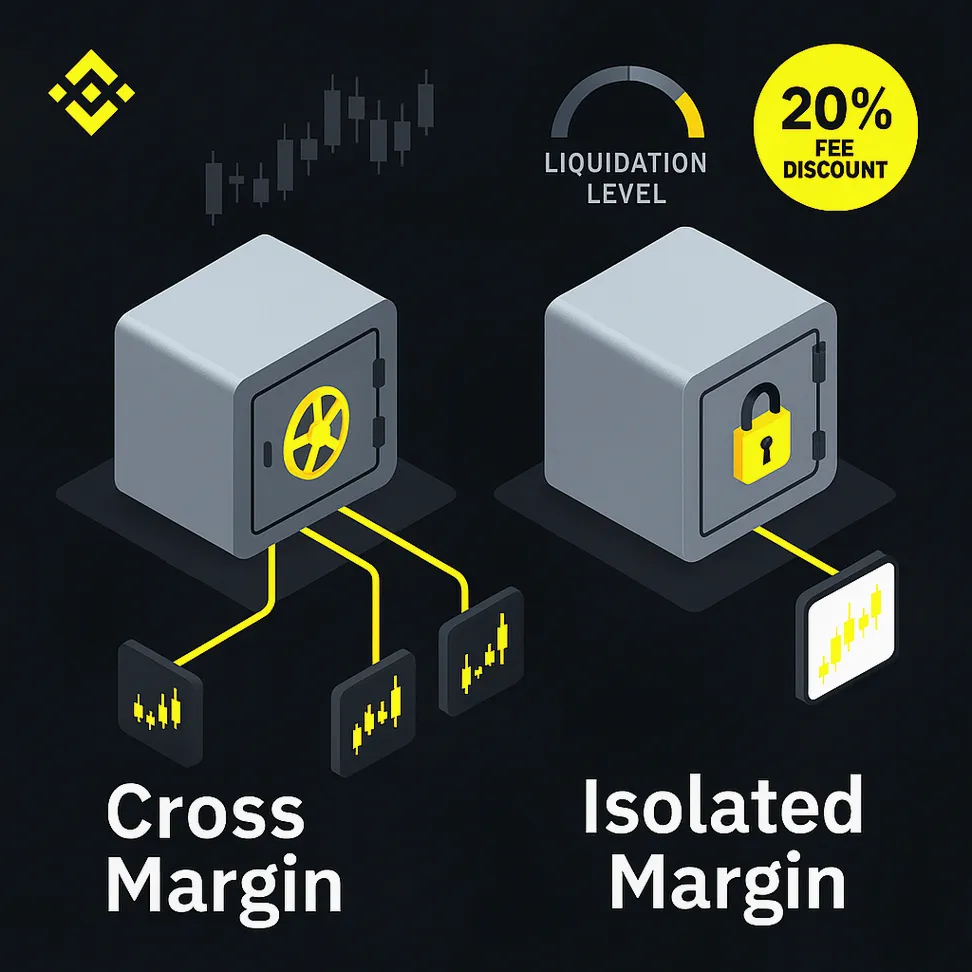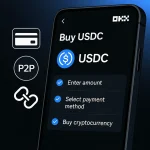Margin modes shape how your risk, collateral, and liquidations behave on Binance. If you’ve ever wondered why a single losing position can threaten your whole account in one mode but not in the other, you’re already asking the right question: what is isolated vs cross margin on Binance and when should you use each?
Use this practical, no-fluff guide to understand the differences, model your risk, and choose a margin mode that matches your strategy and temperament.
- Fast track: If you want fee savings while you learn and trade, register at Binance with the referral code CRYPTONEWER to unlock a 20% fee discount plus up to $10,000 in benefits: Join Binance with code CRYPTONEWER.
Table of contents
- The short version
- Core definitions
- How margin level and liquidation differ
- Spot Margin vs Futures: where modes appear
- Costs: interest, fees, and funding considerations
- When to choose cross vs isolated
- Position sizing and buffers
- Scenario walkthroughs
- How to switch margin mode on Binance
- Common mistakes to avoid
- FAQ: portfolio margin, hedging, and safety
- Start smarter with a fee discount
The short version
- Cross Margin pools your eligible collateral across positions within the same wallet or instrument set. A losing position can draw on your shared balance, helping avoid immediate liquidation but potentially risking your entire pool.
- Isolated Margin fences off collateral to a specific position or pair. Liquidation risk stays contained to that position, letting the rest of your account survive if one trade goes wrong.
If your strategy involves multi-position hedges or you actively rebalance across correlated trades, cross margin can be efficient. If you prefer defined, per-trade risk with hard limits, isolated margin is often the safer default.
Open your Binance account with code CRYPTONEWER for a 20% fee discount and up to $10,000 in benefits.
Core definitions
Cross Margin
- Collateral: Shared across eligible positions in the same margin wallet or market segment (e.g., Cross Margin in Spot Margin; Cross mode in Futures).
- Liquidation: Triggered when your overall margin level hits the platform’s threshold. One bad trade can consume free margin from others.
- Typical use cases: Market-neutral baskets, pair trades, active rebalancing, multi-leg strategies where temporary drawdowns are offset elsewhere.
Isolated Margin
- Collateral: Assigned to a single position or trading pair. You choose how much margin to allocate per position.
- Liquidation: Affects only that isolated position. Losses are ring-fenced.
- Typical use cases: Event-driven trades, speculative entries on volatile assets, learning environments, strict risk budgeting where each trade has a maximum dollar loss.
How margin level and liquidation differ
On Binance, you’ll see a “Margin Level” or similar indicator that combines your asset value, borrowed value, and unrealized PnL. When this metric reaches the liquidation threshold shown in your interface, the platform begins liquidating to repay debt and protect the system.
- Cross Margin: The platform assesses the health of the entire cross pool. Profitable positions may temporarily offset losers. The risk is that a sharp move can drain shared equity, liquidating multiple positions at once.
- Isolated Margin: Health is assessed per position. If one isolated position deteriorates to the liquidation threshold, the platform liquidates just that position while others remain intact.
Tip: Monitor your maintenance margin, interest accrual, and margin level frequently. Liquidation thresholds, interest rates, and maintenance requirements can vary over time and by asset. Always rely on the live values shown on Binance before placing or modifying trades.
Spot Margin vs Futures: where modes appear
- Spot Margin Trading: You borrow assets (e.g., borrow USDT to buy BTC or borrow BTC to short BTC/USDT). Both Cross and Isolated are supported. Interest applies on borrowed assets.
- Futures Trading: You use collateral (e.g., USDT or coin-margined collateral) to open leveraged long/short positions. Futures supports Cross and Isolated margin modes as well, but the mechanics differ from Spot Margin because you’re trading derivatives with mark prices, funding (for perpetuals), and distinct maintenance requirements.
In both Spot Margin and Futures:
– Cross mode shares collateral across eligible positions.
– Isolated mode locks collateral per position.
– The platform shows real-time margin usage, liquidation prices, and thresholds.
Costs: interest, fees, and funding considerations
- Spot Margin interest: You pay interest on borrowed assets. Rates vary by asset and are visible at the time of borrowing. Interest accrues periodically and is charged per Binance’s schedule; confirm the current rate and calculation method in the Borrow interface.
- Trading fees: Maker/taker fees apply to both Spot Margin and Futures. Using a referral can reduce trading fees.
- Futures funding: For perpetual contracts, funding payments occur between longs and shorts at set intervals. Funding is separate from trading fees and can be positive or negative depending on market conditions.
Save on fees from the start. Create your account with the referral code CRYPTONEWER here: Register on Binance. You’ll get a 20% fee discount and can unlock up to $10,000 in benefits. Lower fees help your edge compound.
When to choose cross vs isolated
Choose Cross Margin when:
– You run multiple correlated positions or market-neutral spreads that generally offset one another.
– You actively rebalance and prefer fewer position-level liquidations during normal volatility.
– You have robust risk rules and monitor total portfolio health continuously.
Choose Isolated Margin when:
– You want a hard cap on per-trade loss. If one idea fails, it shouldn’t jeopardize your other trades.
– You trade highly volatile or less liquid pairs with unpredictable tails.
– You’re testing a new strategy and want a clear, ring-fenced sandbox.
Pro insight: Advanced traders sometimes mix both—core hedges in cross for capital efficiency, high-beta bets in isolated for drawdown control.
Position sizing and buffers
Whatever the mode, position sizing and buffers determine your survival.
- Define maximum per-trade risk in dollars or percent of account (e.g., 0.5–2%). Isolated margin enforces this more cleanly.
- Maintain a free margin buffer to reduce liquidation risk. Even in cross, keeping spare collateral improves resilience.
- Use stop-losses that reflect volatility. A stop that’s too tight can cause churn; one that’s too loose can approach liquidation without triggering.
- Rehearse “liquidation math” using the live liquidation price shown on Binance. Adjust leverage, collateral, or position size until the liquidation level sits comfortably beyond your expected noise range.
Scenario walkthroughs
Scenario A: Conservative hedger in Cross
– Account equity: 10,000 USDT
– Positions: Long BTC perpetual, Short ETH perpetual, plus a small altcoin long
– Goal: Earn carry, hedge beta, avoid micro-liquidations
– Outcome: Cross mode lets unrealized profits on BTC offset drawdowns on ETH temporarily. A sharp market-wide drop can still stress the entire pool, so monitoring is essential.
Scenario B: Event-driven trade in Isolated
– Equity: 3,000 USDT
– Position: One isolated long on a volatile altcoin with 4x leverage
– Setup: Define maximum loss at 300 USDT, allocate only that amount plus a buffer to the isolated position
– Outcome: If the trade fails, liquidation or stop-loss closes only this isolated position. Other account balances remain intact.
Scenario C: Margin Spot pair trade in Cross
– Borrow: Borrow USDT to buy BTC and short a correlated instrument (or borrow BTC to sell against USDT)
– Rationale: Small edges in spreads are easier to run in cross when positions hedge each other. Interest cost must be accounted for. Be sure to watch the overall margin level.
How to switch margin mode on Binance
Note: Interfaces evolve. Always double-check the latest UI and confirmation dialogs.
Spot Margin
1) Go to Trade > Margin (on web) or the Margin section in the app.
2) Choose Cross or Isolated for the pair you intend to trade.
3) If using Isolated, allocate collateral and confirm borrowing as needed.
4) Verify interest rates and margin level metrics before placing orders.
Futures
1) Open the Futures trading interface (USDT-M or COIN-M).
2) Find the Margin Mode toggle near the position panel and select Cross or Isolated.
3) Set your leverage per symbol. Leverage is independent from the margin mode choice.
4) Confirm the displayed liquidation price, maintenance margin, and fees.
Common mistakes to avoid
- Over-relying on Cross as a substitute for risk management. Cross is a tool, not a shield. A correlated shock can still liquidate multiple positions.
- Setting leverage first, sizing second. Reverse it: determine your risk, then choose the smallest leverage that meets your target exposure.
- Ignoring interest and funding. Small drips add up. Include these costs when projecting break-even and expected returns.
- Failing to use alerts. Price and margin-level alerts buy you time to rebalance before the platform acts.
- Treating Isolated as “set and forget.” You still need stops and a plan for adverse moves and slippage.
FAQ: portfolio margin, hedging, and safety
-
Is portfolio margin the same as cross margin? No. Portfolio Margin is an advanced framework that may use risk-based offsets across multiple instruments. Cross margin pools collateral within a given wallet or instrument type but doesn’t apply the same risk modeling as portfolio margin. Eligibility and requirements differ—check Binance’s documentation.
-
Can I hedge in isolated mode? Yes, but each leg’s collateral is fenced. You’ll have to manage margin per leg. Many hedgers prefer cross for convenience and capital efficiency; others prefer isolated to limit contagion risk.
-
Where should beginners start? Many start with Isolated to learn position-level risk control. As they layer complexity, they may introduce Cross for baskets or hedges.
-
What triggers liquidation exactly? The platform liquidates when your margin level reaches the threshold displayed in the interface. Thresholds can vary by product and market conditions. Always rely on the live numbers on Binance.
-
Is this financial advice? No. All trading involves risk, including potential loss of principal. Confirm eligibility, taxation, and legal requirements in your region.
Start smarter with a fee discount
If you’re ready to test both margin modes, lower your trading costs from day one. Sign up through this referral to get a 20% fee discount and access up to $10,000 in benefits:
- Register on Binance with referral code CRYPTONEWER
- Referral code: CRYPTONEWER
- Benefits: 20% fee discount on eligible trades and up to $10,000 in platform benefits
Lower fees make risk management easier because slippage and costs have less impact on your edge. Combine that with disciplined margin usage—isolated for ring-fenced bets and cross for managed baskets—and you’ll have a clearer framework for navigating leverage on Binance.





